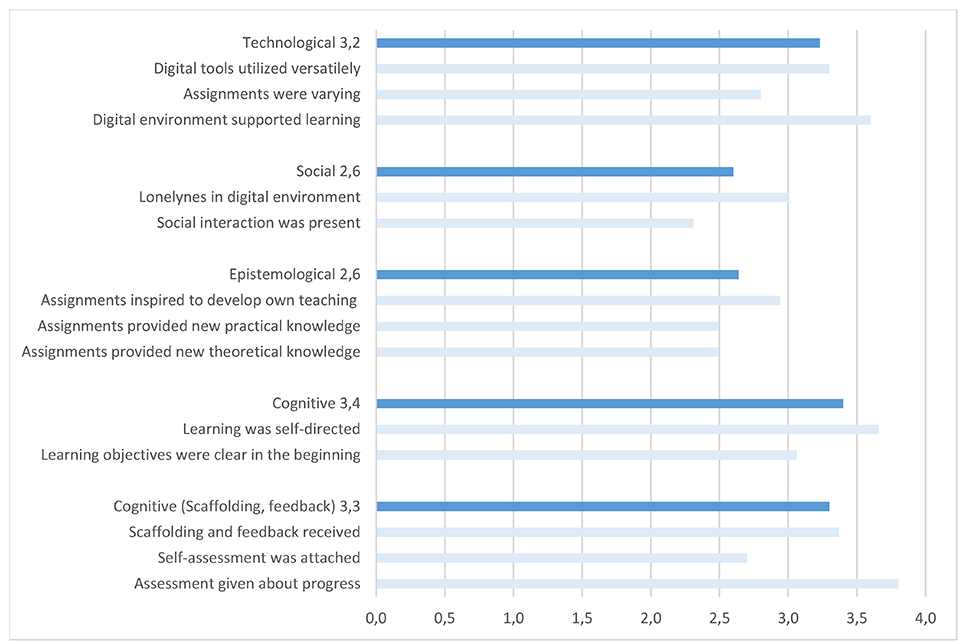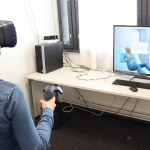
Anne-Maria Korhonen, Jaana-Maija Koivisto & Essi Ryymin
Gamification has increased in vocational education and training (VET) as it has been found to have a wide range of benefits for learning, for example, it improves student engagement, motivation and skills development. For students to get excited about games as a learning method, teachers must also show interest and enthusiasm in game-based learning. Utilizing games in teaching requires a wide range of skills from teachers, especially in the planning, implementation and evaluation of game-based learning. Knowledge and skills related to game pedagogy improve teachers’ teaching experience and self-confidence and reduce the stress they may experience in using games for learning. This, in turn, enables students to have positive and inspiring experiences of the learning situation. (Mäkinen et al., 2020.)
In this article, gamification refers to the use of game design elements in non-game contexts (Detering et al., 2011), which in this case is the context of learning. Furthermore, in this article, the term serious game is used to refer to games that are intended for non-entertainment purposes (Susi et al., 2007). In education, serious games include simulation games, virtual reality games, escape room games, board games, card games and role-playing games, for example. Common to all of these is that games have clear learning goals and contents. What is relevant to learning, however, is that serious games contain motivational affordances, such as a story, challenge, feedback, points, rewards and leaderboards, which provide enjoyment, satisfaction and feelings of achievement. These, in turn, have an impact on learning, skills, competence, task performance and task completion speed. (Hamari et al., 2014.)
Pedagogical infrastructure framework
This study implements the theoretical framework of a technology-enhanced pedagogical infrastructure (Lakkala et al., 2010) (Table 1.) to analyze the use of first aid simulation games in learning. The framework was designed to support collaborative knowledge creation and the design of learning processes in various and complex learning environments. The components of the framework involve technical, social, epistemological and collaborative knowledge creation. The framework has been implemented, for instance, in teacher education context, where it supports student teachers in designing learning activities (Seitamaa-Hakkarainen et al. 2017). The framework is also useful for student teachers’ self-assessment (Korhonen, 2020). The earlier study has revealed that teachers who master digital skills, benefit the most for implementing the framework in teaching practice (Lakkala & Ilomäki, 2015).
Table 1. Technology-enhanced pedagogical infrastructure (Lakkala et al., 2010)
| Component | Definition | Features promoting knowledge creation practices |
|---|---|---|
| Technical | The providing of technology and technical advice to the participants; organizing and orchestrating the use of technology; the functionality of the tools provided; and their appropriateness for the desired activity | a) Providing of technology that enables and facilitates co-construction and elaboration of shared knowledge artifacts and coordination of the collaborative process; b) Easy access to technology in all phases of the process; c) Face-to-face and technology-mediated activities are highly integrated; d) Availability of guidance for using technology for expert-like knowledge practices. |
| Social | The combination of designed individual or collaborative student activities and required outcomes and actual arrangements to organize students’ collaboration and social interaction | a) The whole process is openly shared between the participants; b) Students’ assignments aim at truly collaborative co-construction of knowledge objects; c) A supportive and constructive communication atmosphere is deliberately promoted; d) Students may have direct collaboration with professionals in the target field. |
| Epistemological | The ways of operating with knowledge and the nature of knowledge processing that the assignments promote; nature of knowledge resources used; and the role of participants and information resources while working with knowledge | a) Students are engaged in solving complex, ill-defined problems through practices that explicitly and purposefully aim at creating new knowledge; b) Students use various knowledge sources; c) Knowledge is produced also for subsequent use; d) Students may be engaged in the real practices of a target field. |
| Cognitive | Designed tasks and artifacts or tools performing a modelling and reflective function for promoting students’ self-regulative competencies to work in an intended way | a) Explicit modelling of expert-like knowledge practices through concrete models and templates; b) Methods used to promote self-reflection; c) Guidance provided for students about effective working strategies; d) Explicit scaffolding for collaborative knowledge creation process embedded in tools. |
Lakkala and her colleagues (2010) note that the framework is rather general and thus more detailed guidelines and examples are needed for teachers so that they can create learning designs successfully (Lakkala et al., 2010; Korhonen, 2020). Recent research by Korhonen, Lakkala and Veermans (2019) defines the components of the framework more specifically on practical levels. Korhonen and her colleagues (2019) analysed vocational student teachers’ learning designs and found three different levels in each component. In the technical component the levels described how many learning environments were implemented. In the social component the levels explored are students working alone, in pairs or collaboratively. In the epistemological component the levels featured theoretical, authentic, or new knowledge creating learning assignments. And finally, in the cognitive component, the levels described orientation to learning activities, personalized learning and self-assessment. Further, in regard the cognitive component, the levels displayed the perspectives of teachers’ activities such as feedback giving and scaffolding. (Korhonen, Lakkala & Veermans, 2019.)
Gamification in vocational education
One of the greatest benefits of using games in vocational training is that they offer authentic real-life situations to learners who can transfer the knowledge and skills to real working situations and processes. Games are well suited for industries with high occupational safety risks, especially for training situations that are otherwise difficult to practice. The use of games enables self-directed learning based on the needs of the learner. Therefore, they are very useful forms of microlearning referring to short-term learning units. To learn the skills needed in the profession, such short motivational learning moments allow workers to practice simple but also challenging working situations. (Ahrens, 2015.)
In vocational education, game-based learning has been used to simplify complex matters. Dochtsis and colleagues (2021) developed an escape room game which aimed to teach the user the basics of digital electronics. One previous study found that a multiplayer 3D-game environment enriched the learning activities of 16–18-year-old vocational students in a simulated work safety story (Hämäläinen et al., 2008). The game environment guided players to proceed through different phases in a theory-based simulated story. Another study had similar results showing that a 3D simulation game guided nursing students to follow the clinical reasoning process and helped them practice clinical reasoning skills by being an active participant in patient care in the game (Koivisto et al., 2016). User experience (UX) has a great impact on learning (Zaharias and Pappas, 2016). In immersive virtual environments, UX refers to factors such as immersion, presence, flow, and engagement (Tcha-Tokey et al. 2018). In educational context, it has been found that UX is highly individual and vivid (Salovaara-Hiltunen et al., 2019).
The purpose of the study and the research questions
The purpose of this study is to describe vocational teacher students’ analyses and experiences of first aid simulation games, and their interest in implementing simulation games in their own teaching. The study aims to determine the components that the student teachers highlighted in an analysis following Lakkala and her colleagues’ framework (2010) and what the motivational elements of the games were.
The research questions were:
- Did the studied first aid simulation games include the components of the technology-enhanced pedagogical infrastructure framework from the vocational student teachers’ perspective?
- What kind of motivating elements were included in the first aid simulation games from the vocational student teachers’ perspective?
- What were the student teachers’ considerations concerning the implementation of simulation games in their own teaching?
Methodological approaches
The participants of the study were 36 vocational teacher students from a vocational teacher education program (60 ECTS). The participants represented several disciplines from vocational education and training, and higher education from the universities of applied sciences.
The theme of the simulation games in this study was chosen to be first aid because it benefits all disciplines. The games used in the study consisted of two basic first aid scenarios: ‘How to stop bleeding’ and ‘How to help an unconscious person’. Previously, simulation games have been found to be an effective method in nursing education (Koivisto et al., 2020). The game was developed with the Unity3D development platform, and it was a single-player game played in the first-person view. For the purpose of this study, first aid scenarios were chosen since first aid skills are important for all citizens and therefore the content was thought to be suitable for all participants. The content of the first aid scenarios was based on the Finnish Red Cross first aid instructions. Non-linear gameplay allows the player to move forwards and backwards between different sections in the game: assess the situation, find out what has happened and how to call 112 for help, and administer emergency first aid. In the first aid simulation games, the player finds a 3D character with authentic reactions in a home environment needing help. The player can observe the person’s condition with the help of authentic graphics and animations. During the game, players receive feedback which enables them to analyse and reflect on their decisions as well as to track their skills development. (See Salovaara-Hiltunen et al., 2019.)
The participants were given an assignment 1) to play the described games using a computer, and 2) to assess the games process by answering a questionnaire following the technology-enhanced pedagogical infrastructure framework (Lakkala et al., 2010) and a related practical evaluation frame (Korhonen, Lakkala & Veermans, 2019). The items were rated using a five-point Likert scale where a score of five indicated a response of ‘very much’, and a score of one indicated a response of ‘not at all’. In addition, the teachers answered open questions concerning the development of their own teaching practices and implementation of simulation games in their own disciplines. The participants played the game and answered the questionnaire remotely and independently in their own time.
The questionnaire was analysed with descriptive statistics (Polit & Beck, 2019). The analysis of the qualitative research data collected from the open questions loosely followed the thematic analysis introduced by Braun and Clarke (Braun & Clarke, 2006; Terry et al., 2017). The analysis process was both a theory- and data-driven with a specific focus on the theoretical framework of the technology-enhanced pedagogical infrastructure framework described previously (Lakkala et al., 2010) and UX experience elements (Mandal, 2013; Tcha-Tokey et al. 2018).
Results
Overall, the results show that the learning process in the first aid simulation games was pedagogically meaningful (Figure 1). The component technology was studied via three questions, with an average score of 3.3 out of 5.0. The social component was studied via two questions, with an average score of 2.5. The epistemological component was studied via three questions, with an average score of 2.3. The cognitive component featuring learning assignments got an average score of 3,5 and teachers’ activities an average score of 3,3.
The games in question in this study were found to be technically above average as a learning environment. This indicates that these games included diverse forms of assignments on the simulation game platform. Social interaction and collaboration with peers (or some others) are in the average level, which is a small surprise since participants were playing the games alone. It might indicate that the in-game facilitator was experienced to be supportive also in social means. Epistemologically participants considered that simulation game provided information, both theoretical and practical, but below average. Cognitive component featuring clear learning objectives and self-assessment processes was found over average. Finally, the support and assessment in simulation games was found a bit over average.

Motivating elements in the simulation game
Overall, the participants thought the simulation game and first aid scenarios were motivating. The motivation arose mainly because the scenarios felt like real situations, the gaming was a practical way to learn, the scenarios progressed logically and the things to be learned were broken down into small parts. However, not everyone was excited about playing the game.
One of the participants noted:
“I found myself excited, so the situations were obviously real”.
The personality and visual appearance of the game were motivating as well as the active participation required in the first aid situations. One participant felt good about being allowed to try in own time. Another participant particularly liked the game’s encouraging attitude, which inspired experimentation without fear. The support of the in-game facilitator encouraged the participants to make decisions. Some players reported that they would have liked more options and greater difficulty in the game.
One participant said:
“The simulation worked surprisingly well in that task. … Encouragement in a situation helps with learning.”
The participants overall demonstrated that feedback was an important motivating element in the game: receiving personal feedback during playing and at the end of the game. One participant felt that the best thing was to get immediate feedback in a concrete first aid situation. In addition, guiding feedback was felt to be important as well. However, going through the performance at the end of the game would have also been desirable. Some needed more detailed feedback on the order in which they really need to act in a first aid situation and what things would need special attention the next time they played.
One learner said:
“I felt that the learning happened because I repeated the tasks in the hope of better points.”
Considerations on the implementation of simulation games
When the student teachers reflected on the development of their own teaching practices and implementation of simulation games in their own disciplines, they speculated on the epistemological component (Lakkala et al., 2010). They highlighted the importance of engaging students to solve real-life problems in virtual learning games and creating new knowledge. Further, cognitive components (Lakkala et al., 2010) were paid attention in planning, especially guidance and scaffolding a student’s learning process through the simulation game. The possibility to receive feedback was considered valuable for the learning processes.
One of the student teachers reflected:
“The best element in the simulation game was that you received direct feedback on a real world (simulated) learning situation.”
In line with the user experience elements introduced by Mandal (2013) and Tcha-Tokey (2018), the reflections of the student teachers emphasized engagement, skills, emotions, judgement and technology adoption, when they considered the implementation of the simulation game in their own teaching. For instance, they expressed judgements on the development needs of the simulation games. Some of the teachers were critical towards the simulation games and felt that they were too simple and not as complex as real-life learning situations truly are. One of the participants planned to adopt this sort of technology as an orientation tool in the learning process. This participant felt that later, practical rehearsals in authentic learning environments and guided group-discussions could deepen the knowledge and skills learned in the virtual games.
Discussion
Based on the results it seems that there is room to apply the technology-enhanced pedagogical infrastructure framework (Lakkala et. al, 2010) for designing and assessing simulation games. However, even though a practical assessment frame for designing the learning process (Korhonen, Lakkala & Veermans, 2019) was utilizsed, more attention needs to be paid to formulating detailed and practical guidelines such as the technology-enhanced pedagogical infrastructure for simulation games.
The second question in this study was to describe the motivating elements in the studied simulation games. It is interesting to note that the same elements were perceived as motivating as in previous studies (e.g. Hamari et al., 2014) although the issues were examined from the perspective of student teachers. The participants found the authenticity of the games to be particularly good for learning, which has earlier been found to be a significant facilitator of learning in simulation games (Koivisto et al. 2018). These results further support the idea that the logical progression of games motivates learners, because games guide them to proceed in different tasks in the order of real-life working processes. This matches the results observed in earlier studies (Hämäläinen et al., 2008; Koivisto et al., 2016). This study supports evidence from previous observations (e.g., Hamari et al., 2014; Koivisto et al., 2018; Salovaara-Hiltunen et al., 2019) of the importance of feedback. Different feedback systems in games motivate learners to try for better performance. Feedback also provides information on the learner’s level of competence and what needs to be studied more.
According to study results, the student teachers were interested in implementing simulation games in their own teaching practices and they reflected critically on the possibilities and development needs of simulation games in learning. They highlighted the importance of the role of the participants, scaffolding, feedback and the knowledge and skills targeted to be developed within the games.
Taken together, the teacher students found simulation games pedagogically designed, motivating and implementable in their own teaching with some critical considerations. Further research is needed to explore how student teachers design their simulation games learning processes and how the technologically enhanced pedagogical infrastructure could support them in this pursuit.
Authors
Anne-Maria Korhonen, Principal Research Scientist, HAMK Edu
Jaana-Maija Koivisto, Principal Research Scientist, HAMK Smart
Essi Ryymin, Principal Research Scientist, HAMK Edu
References
Ahrens, D. (2015). Serious Games – A New Perspective on Workbased Learning. Procedia – Social and Behavioral Sciences, 204, 277‒281. https://doi.org/10.1016/j.sbspro.2015.08.152.
Deterding, S., Dixon, D., Khaled, R. & Nacke, L. (2011). From game design elements to gamefulness: Defining Gamification. Proceedings from MindTrek ’11. Tampere: ACM.
Dochtsis, R., Kotsifakos, D. & Douligeris, C. (2021). An Escape Room Game for Learning Digital Electronics in Vocational Education and Training (VET). In Auer, M.E., Tsiatsos, T. (Eds) Internet of Things, Infrastructures and Mobile Applications. IMCL 2019. Advances in Intelligent Systems and Computing, Vol. 1192. Springer, Cham. https://doi.org/10.1007/978-3-030-49932-7_62
Hamari, J., Koivisto, J. & Sarsa, H. (2014). Does gamification work? – a literature review of empirical studies on gamification. In 47th Hawaii international conference on system science. DOI: 10.1109/HICSS.2014.377
Hämäläinen, R., Oksanen, K. & Häkkinen, P. (2008). Designing and analyzing collaboration in a scripted game for vocational education. Computers in Human Behavior, 24(6), 2496‒2506. https://doi.org/10.1016/j.chb.2008.03.010.
Koivisto, J-M., Rosqvist, K., Buure, T., Engblom, J. & Haavisto, E. (2020). The effectiveness of a simulation game on nursing students’ self-evaluated clinical reasoning skills: A quasi-experimental study. Hoitotiede, 32 suppl, 36‒45.
Koivisto, J-M., Haavisto, E., Niemi, H., Haho, P., Nylund, S, & Multisilta, J. (2018). Design principles for simulation games for learning clinical reasoning: A design-based research approach. Nurse Education Today, 60, 114‒120. doi: 10.1016/j.nedt.2017.10.002.
Koivisto, J-M., Multisilta, J., Niemi, H., Katajisto, J. & Eriksson, E. (2016a). Learning by playing: A cross-sectional descriptive study of nursing students’ experiences of learning clinical reasoning. Nurse Education Today, 45, 22–28. doi:10.1016/j.nedt.2016.06.009.
Korhonen, A.-M. (2020). Designing scaffolding for personal learning environments: Continuous learning perspective in vocational teacher education context (Annales Universitas Turkuensis B 516) [dissertation, University of Turku]. http://urn.fi/URN:ISBN:978-951-29-8124-3
Korhonen, A.-M., Lakkala, M. & Veermans, M. (2019). Identifying vocational student teachers’ competence using an ePortfolio. European Journal of Workplace Innovation, 5(1). https://doi.org/10.46364/ejwi.v5i1.512
Lakkala, M. & Ilomäki, L. (2015). A case study of developing ICT-supported pedagogy through a collegial practice transfer process. Computers & Education, 90(1), 1–12.
Lakkala, M., Ilomäki, L. & Kosonen, K. (2010). “From instructional design to setting up pedagogical infrastructures: designing technology-enhanced knowledge creation.” In Technologies and practices for constructing knowledge in online environments: Advancements in learning (pp.169‒185). New York, NY: Information Science Reference.
Polit, DF. & Beck, CT. (2017). Nursing research: generating and assessing evidence for nursing practice. Tenth edition Edition. Wolters Kluwer Health. Philadelphia.
Salovaara-Hiltunen, M., Heikkinen, K. & Koivisto, J-M. (2019). User experience and learning in a 4D virtual reality simulation game. International Journal of Serious Games, 6(4), 49–66. http://doi.org/10.17083/ijsg.v6i4.305
Seitamaa-Hakkarainen, P., Härkki, T., Lahti, H. & Hakkarainen, K. (2017). Pedagogical infrastructures of design studio learning. Journal of Textile Design Research and Practice, 4(2), 155–181.
Susi, T., Johannesson, M. & Backlund, P. (2007). Serious games: An overview (Technical Report HS IKI TR 07 001). Skövde: University of Skövde .
Tcha-Tokey, K., Christmann, O., Loup-Escande, E., Loup, G. & Richir, S. (2018). Towards a model of user experience in immersive virtual environments. Advances in Human–Computer Interaction, 1–10. https://doi.org/10.1155/2018/7827286
Zaharias, P. & Pappas, C. (2016). Quality management of learning management systems: A user experience perspective. Current Issues in Emerging eLearning, 3(1), 60–83.





